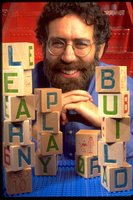
While following up on the the Future of Entertainment Chart I came across this article
Computer as Paint Brush: Technology, Play, and the Creative Society
Mitchel Resnick MIT Media Laboratory
Singer, D., Golikoff, R., and Hirsh-Pasek, K. (eds.), Play = Learning: How play motivates and enhances children's cognitive and social-emotional growth. Oxford University Press.
Heres a sample
Learning through Designing
Children have many opportunities to interact with
new technologies – in the form of video games, electronic storybooks, and “intelligent”
Research has shown that many of children’s best learning experiences come when they
inventing with them (Papert, 1980; Resnick, 2002). In the process of designing and
This design cycle can be seen as a type of play – children play out their ideas with each
new creation. In design activities, as in play, children test the boundaries, experiment
with ideas, explore what’s possible. As children design and create, they also learn new
concepts. When they create pictures with a paint brush, for example, they learn how
colors mix together. When they build houses and castles with wooden blocks, they learn
about structures and stability. When they make bracelets with colored beads, they learn
about symmetries and patterns.
In my research group at the MIT Media Lab, our goal is to develop new technologies that
follow in the tradition of paint brushes, wooden blocks, and colored beads, expanding the
range of what children can create, design, and learn. Our Programmable Brick
technology, for example, is a natural extension of the LEGO brick. The original LEGO
brick, developed in the 1950s, enabled children to build structures like house and castles.
In the 1970s, the LEGO Company expanded its construction kits to include gears,
pulleys, and other mechanical parts, enabling children to build their own mechanisms.
Programmable Bricks, which we developed in the 1990s in collaboration with the LEGO
Company, represent a third generation. With these new bricks, children can program their
LEGO creations to move, sense, interact, and communicate. Now, children can build not
only structures and mechanisms but also behaviors.
Programmable Bricks are commercially available as part of a robotics kit called LEGO
Mindstorms. Over the past decade, there have been hundreds of different robotic toys on
the market, but Mindstorms is fundamentally different. With most robotic toys, children
simply interact with a pre-built robot. With Mindstorms, children create their own robots:
they use gears, axles, pulley, and cams to build the mechanisms, connect motors to drive
the motion, attach sensors to detect conditions in the world (temperature, light levels,
etc.), and write computer programs to guide the robot’s behavior (turning motors on and
off based on inputs from the sensors).
By creating their own robots, children gain a deeper understanding of the ideas
underlying the workings of robots. In one fifth-grade class, for example, students used a
Programmable Brick to create a LEGO dinosaur that was attracted to flashes of light, like
one of the dinosaurs in
To make the dinosaur move toward the light, the
students needed to understand basic ideas about feedback and control.
They wrote a
veer back to the right; if the dinosaur went too far right (more light in the left eye), the
program corrected it toward the left. This classic feedback strategy is typically not taught
until university-level courses. But with the right tools, fifth graders were able to explore
these ideas
(Resnick, Bruckman, & Martin, 1996).
No comments:
Post a Comment